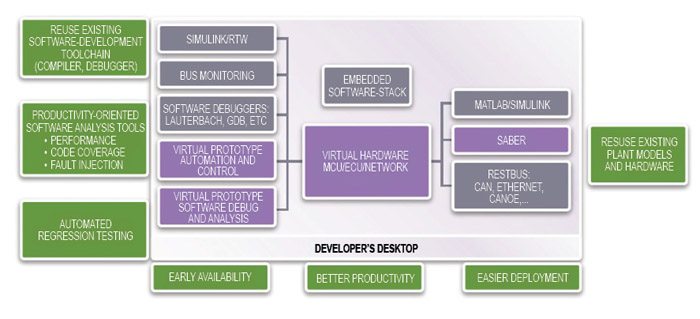Advantages of using Saber for in-vehicle network. Saber makes it easy to verify network concepts and topologies early in the development cycle, thus sparing designers the cumbersome task of integrating code later. Using Saber, it is possible to analyse specific network variants (for example, minimum vs maximum number of electronic control units), which saves more time while eliminating errors with the help of industry-proven IVN libraries. In order to analyse possible topology extensions, Saber comes with the ability to include wire characteristics to the design. This feature increases robustness while increasing analysis throughput.
Powertrain and hybrid-electric vehicle systems. Consumer demand for higher fuel efficiency and lower vehicle emissions has accelerated the development of pure electric (EV) and hybrid electric (HEV) drive-trains. These vehicles depend on advanced electronically-controlled systems working together across a wide range of operating conditions to ensure efficient performance, safety and reliability. Increasing electrical content and complexity, coupled with shorter design cycles, require design teams to continually improve their design methods for mechatronic integration. To minimise risk and potential recall or re-design, engineers rely on simulation-based robust design methods to deliver predictable and reliable designs. Saber’s comprehensive modeling, simulation and analysis capabilities are applied to improve system performance, reduce cost and maximise reliability of these critical systems.

Saber advantages in HEV/EV systems. Design engineers can use Saber to evaluate design architecture trade-offs—be it parallel, serial or any other complex topology—along with analysis of power generation and distribution for motor drives and controls, regenerative braking, power assist, etc. Saber also incorporates multi-domain (mechanical, electrical, thermal and magnetics) effects at the system level. Designers can design, test and verify control strategies, power management, torque/speed coupling and vehicle dynamics while being able to optimise the cost, system performance and reliability with advanced sensitivity, stress and statistical analyses.
Wire harness design and simulation. Wire harnesses form the backbone of the entire electrical system of automotive and aerospace vehicles. Their reliable implementation represents one of the most expensive and technically challenging aspects of vehicle systems design. Saber harness provides proven design and verification capabilities in conjunction with Saber simulator to create correct-by-design wire harnesses. Designers can also create schematic drawings and connectivity diagrams, export components and wire data, import required geometry information from MCAD tools, simulate electrical functions, create bundles with connector positions and generate data for manufacturing—all within an easy-to-use design tool.
Saber advantages for wire harness design and simulation. Saber lets designers analyse electrical systems before layout and manufacturing, eliminating system failure in production. It also provides an integrated data flow for electrical system design from concept to manufacturing. It minimises data entry and manual checking tasks, and automates data processing steps while maintaining data integrity. The software integrates seamlessly with popular 3D CAD tools like Catia V5, UGS and Pro/E.
View the possibilities
To get the first-hand impression of Synopsys Saber simulator for automotive sector, download the software from here. Please note that you need at least 1.4 GB of free space on your hard disk for the installation.
The author is a tech correspondent at EFY






